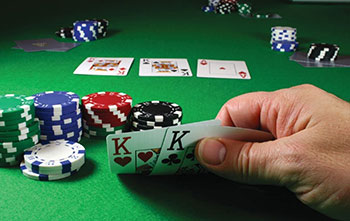THE THREE R’s OF POKER
The methodical approach to winning at the tables
By Jack Clayton
 All right, everyone, are you ready for a nap? Because today’s poker exercise will be lucky to cause a blip on the excitement meter. Or as Groucho Marx once quipped, “I thought my razor was dull until I heard that speech.”
All right, everyone, are you ready for a nap? Because today’s poker exercise will be lucky to cause a blip on the excitement meter. Or as Groucho Marx once quipped, “I thought my razor was dull until I heard that speech.”
Okay, dull is the wrong term. Methodical is more apt. But if you want to enhance your poker skills let’s get into the “Three Rs” of poker: Ranges, Rote and Reason. They might not electrify you enough to blast away on social media about their purpose and intricacies. However, if you want to improve your game – and your bankroll – by evolving from an average player to a great one you need to understand, practice and fine tune these three rolling Rs.
Range
Focus on the ranges of cards in poker, not the individual hands. Weak to average players try and guess what cards their opponent has, while experts think in terms of card ranges. A range is the whole spectrum of potential hands somebody can have in each situation.
An astute player will use deduction to identify the ranges the opponent has. Not what two cards the other player is holding, but the range that is likely. For instance, if you have a pair of nines and everyone calls, you can deduce no one has a pair better, as someone holding 10-10, J-J, K-K, Q-Q,A-K and A-A would have raised pre-flop, not called.
At that stage you can deduce the other players’ cards are likely A-J, K-Q and below. Granted, the range of cards is large at this point, but you’ve started by gauging what’s not there, which helps pare down the ranges left, the first step of a calculated methodical process. All of these are important cognitive deductions that are on-going with the best poker players.
Next comes the flop. Let’s say the cards are 8 of clubs, 7 of clubs and 3 of spades. If your opponent calls again you can eliminate a large swath of hands. Chances are if your opponent hit a pair on any of those flops he would have raised. What’s left would be sets, draws (incomplete hands), two-pair hands and weak one-pair hands. Players would probably call with hands such as K-Q to 5-6 in clubs, 3-3, 7-7, 8-8, or a shot at a flush or straight, such as 5-6, 5-9 in clubs.
When the turn comes, you get still further information on your opponents, depending on the card and reactions. If the turn is a club, you raise and your opponent goes all in, there’s a decent chance he has a flush, a straight or three of a kind. In that case, it’s time for you to get out. However, if he calls, you can deduce he doesn’t have the nuts and you move forward. The catch is to keep track of all the cards in your head while deducing what range your opponents likely have. It’s all about calculating information, and card range is really the best tool you can master to improve your game.
Rote
It’s easy to think about changing your strategy at the poker tables. Maybe things aren’t going your way and you contemplate making adjustments small or large. Maybe you have a hunch that after 10 straight losing hands this next one will be a monster – it just has to be. You can feel it, or sense the law of averages are about to shift in your favor.
Simply put, elite poker players don’t do that. The best of the best keep track of all of the cards, understand the mathematics of each hand, and usually play it the same way. Yes, that may be boring. But it’s how to maximize winning. And if your goal is to win consistently, it’s not mundane tallying your profits like a pro. Know the numbers, fine tune your system and stick to it.
Reason
With that said, it’s not etched in stone, either, as the best players will stray a bit from their honed strategies at times, but there have to be reasons for it. You want to have clearly defined explanations for every move you make. For instance, a good player would normally fold with a 6 and 8 off-suit. But there are times when you can call or even raise, such as if you notice your opponents are consistently playing passive, checking and calling often.
Another example is the ability to fold even when you have an overpair, the highest visible cards on the table. If you have an overpair, but a tight player suddenly brightened up and raises, the odds are they finally have that strong hand they’ve been waiting for. The best play might be to take the small loss and get out. Novice players often get so enamored with the potential of their high cards that they stay in no matter what.
However, a great player doesn’t get tied down to those enticing looking high cards. They won’t flinch a second when thinking about bailing out when circumstances dictate. Simply put, don’t be afraid to fold.
Don’t fool yourself into thinking things may break in your favor when your mind is telling you otherwise. Which is similar to another comment from Groucho when he was leaving a dinner party: “I’ve had a wonderful evening, but this wasn’t it.” After all, it’s only one hand. Playing the percentages, knowing your opponents, and consistently playing honed strategies is the way to morph from a break-even player to a winning one.


